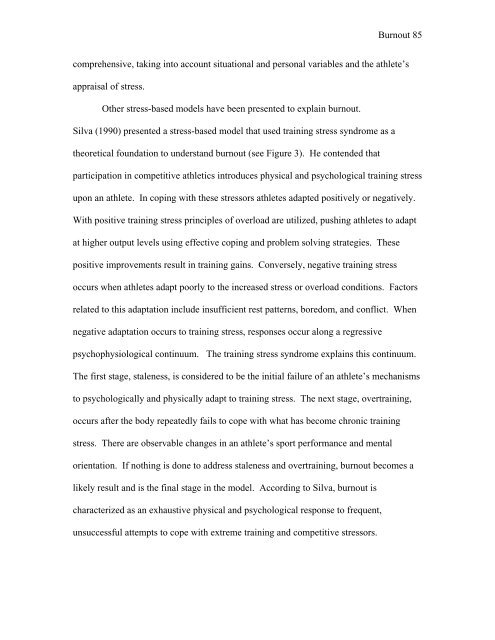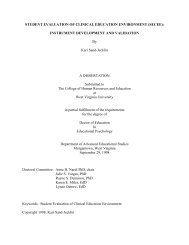Coach and Athlete Burnout - West Virginia University
Coach and Athlete Burnout - West Virginia University
Coach and Athlete Burnout - West Virginia University
Create successful ePaper yourself
Turn your PDF publications into a flip-book with our unique Google optimized e-Paper software.
<strong>Burnout</strong> 85<br />
comprehensive, taking into account situational <strong>and</strong> personal variables <strong>and</strong> the athlete’s<br />
appraisal of stress.<br />
Other stress-based models have been presented to explain burnout.<br />
Silva (1990) presented a stress-based model that used training stress syndrome as a<br />
theoretical foundation to underst<strong>and</strong> burnout (see Figure 3). He contended that<br />
participation in competitive athletics introduces physical <strong>and</strong> psychological training stress<br />
upon an athlete. In coping with these stressors athletes adapted positively or negatively.<br />
With positive training stress principles of overload are utilized, pushing athletes to adapt<br />
at higher output levels using effective coping <strong>and</strong> problem solving strategies. These<br />
positive improvements result in training gains. Conversely, negative training stress<br />
occurs when athletes adapt poorly to the increased stress or overload conditions. Factors<br />
related to this adaptation include insufficient rest patterns, boredom, <strong>and</strong> conflict. When<br />
negative adaptation occurs to training stress, responses occur along a regressive<br />
psychophysiological continuum. The training stress syndrome explains this continuum.<br />
The first stage, staleness, is considered to be the initial failure of an athlete’s mechanisms<br />
to psychologically <strong>and</strong> physically adapt to training stress. The next stage, overtraining,<br />
occurs after the body repeatedly fails to cope with what has become chronic training<br />
stress. There are observable changes in an athlete’s sport performance <strong>and</strong> mental<br />
orientation. If nothing is done to address staleness <strong>and</strong> overtraining, burnout becomes a<br />
likely result <strong>and</strong> is the final stage in the model. According to Silva, burnout is<br />
characterized as an exhaustive physical <strong>and</strong> psychological response to frequent,<br />
unsuccessful attempts to cope with extreme training <strong>and</strong> competitive stressors.












